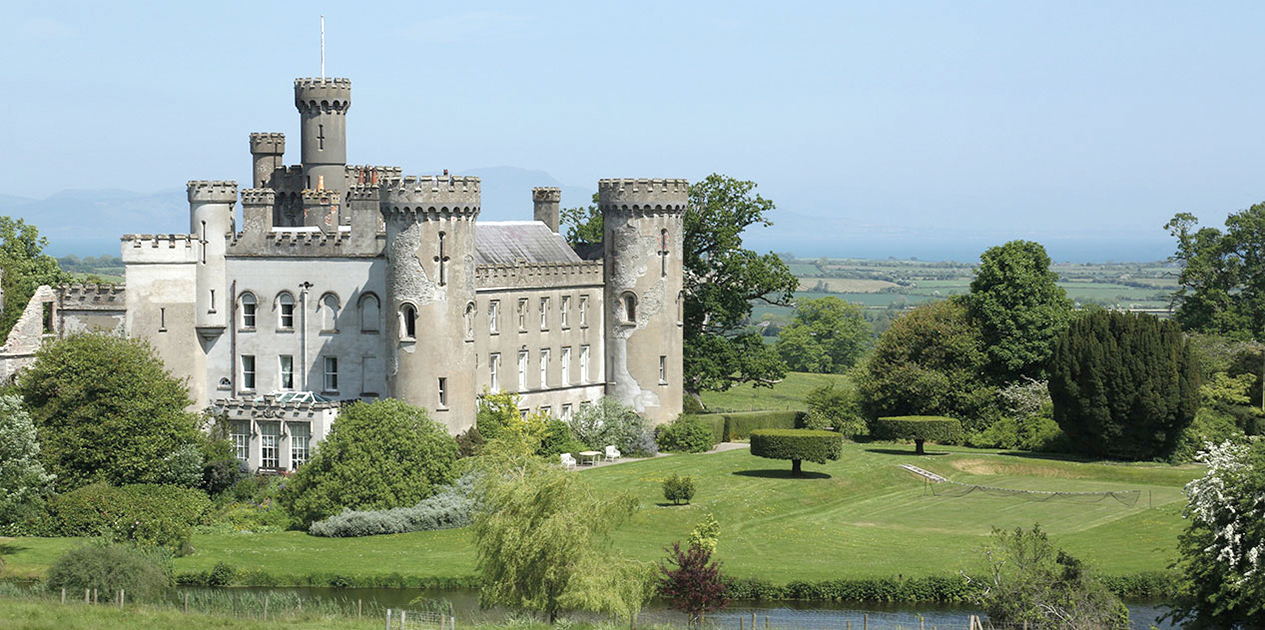Barmeath Castle
Barmeath Castle stands proudly on the sheltered slopes of a wooded hillside in County Louth, looking out over the park to the mountains of the Cooley Peninsula and a wide panorama of the Irish sea. The Bellew family was banished to Connacht by Cromwell but acquired the Barmeath estate in settlement of an unpaid bill. The medieval tower house was twice remodelled and extended, and was subsequently crenellated in the neo-Norman style. The extensive rococo pleasure grounds were designed by the visionary architect, Thomas Wright of Durham, and include an ornamental lake, a rustic bridge, an archery ground and an unusually large walled garden.
Reputedly Queen Maeve established a camp at Barmeath before her legendary cattle raid, which culminated in the capture the Brown Bull of Cooley, as recounted in the famous epic poem, The Tain. Indeed the name Barmeath is said to derive from the Gaelic Bearna Mheabh or Maeve’s Pass.
The Bellew family, among the first Normans in Ireland, settled at Castle Roche on the border between County Louth and the neighbouring county of Armagh. The family expanded into different branches until John Bellew of Lisryan fought against Cromwell, lost his estates and was banished to Connacht. A wily lawyer, trained at the English bar, Bellew appears to have retained his Louth connections while living and marrying in County Galway, since he was engaged by the dispossessed Theobald Taaffe, Lord Carlingford, to represent him at the Court of Claims on the Restoration of King Charles II.
An ardent royalist, Carlingford had also lost his estates by supporting Charles I and was in high favour with the new king. Their friendship gave Bellew a considerable advantage when pleading his client’s cause and he successfully negated an award of 10,000 acres in reparation. Instead of paying Bellew’s bill for £700, which seems more than a little excessive, Carlingford gave him a portion of his newly acquired estates, consisting of 2,000 acres at Barmeath where the previous owners, the Moore family, had built a tower house in the fifteenth century.
A two-storey wing was added in around 1700 and was followed, towards the middle of the century, by a large three-storey Georgian house, incorporating the walls of the original tower. The plain exterior is a perfect foil for the rich interior, which is particularly notable for the quality of the joinery, carving and plasterwork. The great mahogany staircase, with Corinthian balusters and a heavy, swooping handrail that culminates in a luxuriously exaggerated spiral, is particularly fine as are the landing and library on the piano nobile, where the bookcase doors with their complicated geometric astragals are separated by ionic pilasters and surmounted by broken pediments.
The library ceiling is remarkable for an impressive array of Masonic symbols in the rococo plaster ceiling. Lodge meetings were held in this room until a Papal dictat obliged the owner to absent himself in deference to his religious beliefs, though he still permitted his fellow Masons to continue their meetings until his death.
In the early nineteenth century the first Lord Bellew commissioned a Hertfordshire architect, Thomas Smith, to turn the house into a neo-Norman castle with crenellations, round corner turrets and a tall square tower at one end of the side elevation, which became the new principal entrance. Smith also remodelled some of the interiors in a restrained Gothick style.
The lake and pleasure grounds were designed by the garden designer and polymath, Thomas Wright of Durham (1711-1785), who visited Ireland in 1746 at the invitation of Lord Limerick and designed a series of garden buildings on his estate at Tollymore in County Down. Wright explored 'the wee county' extensively and his book "Louthiana", which describes and illustrates many of its archaeological sites, is among the earliest surveys of its type. His preoccupation with Masonic ‘craft’ indicates that Wright is likely to have been a Freemason, which probably helped to cement his friendship with the Bellew of the day. He may well have influenced the design for the Barmeath library and indeed the mid-eighteenth century house.
Wright’s highly original layout, which is contemporary with the house, is remarkably complete and important, and deserves to be more widely known. It includes a small lake, an archery ground, a maze, a hermitage, a shell house and a rustic bridge, while the four-acre walled garden has recently been restored.
John Bellew’s son Patrick was High Sheriff of Louth and was made a baronet by James II. The seventh baronet, another Patrick and MP for County Louth, was created an Irish peer in 1844. The present owner, Bryan, the 8th Lord Bellew of Barmeath, is John Bellew’s direct descendant.
The family did not end their presence in Connacht on returning to County Louth, though eventually their County Galway estate passed to the Grattan-Bellew family, descendants of a younger son, who established a thriving market town, Mount Bellew, at the gates of their demesne.
Address & Contact
Barmeath Castle, Togher, Dunleer, Loutht: 041 6851205
Available as a Film Location
Houses and Garden
Individual House Visits
Groups by Arrangement
Individual Garden Visitors
Culture and Education
Concerts, Plays or Recitals
Educational Visits


